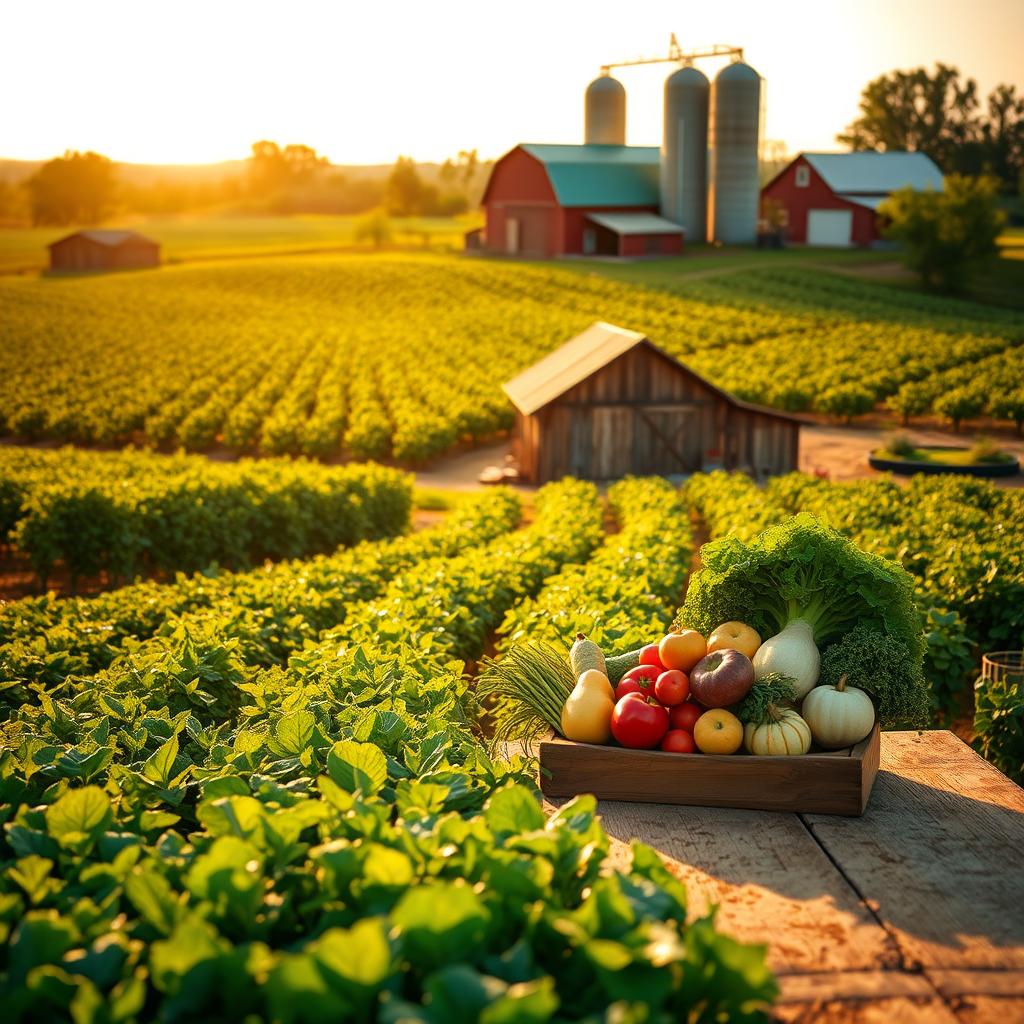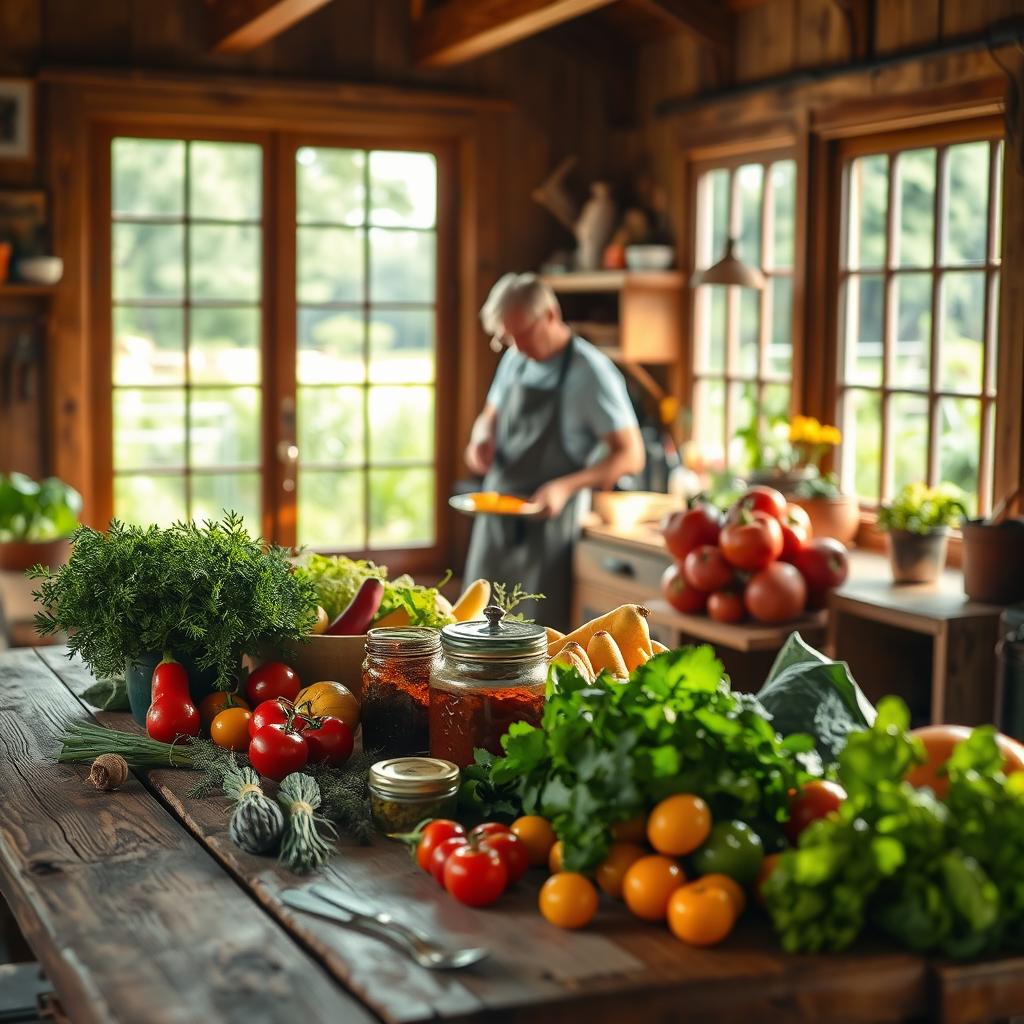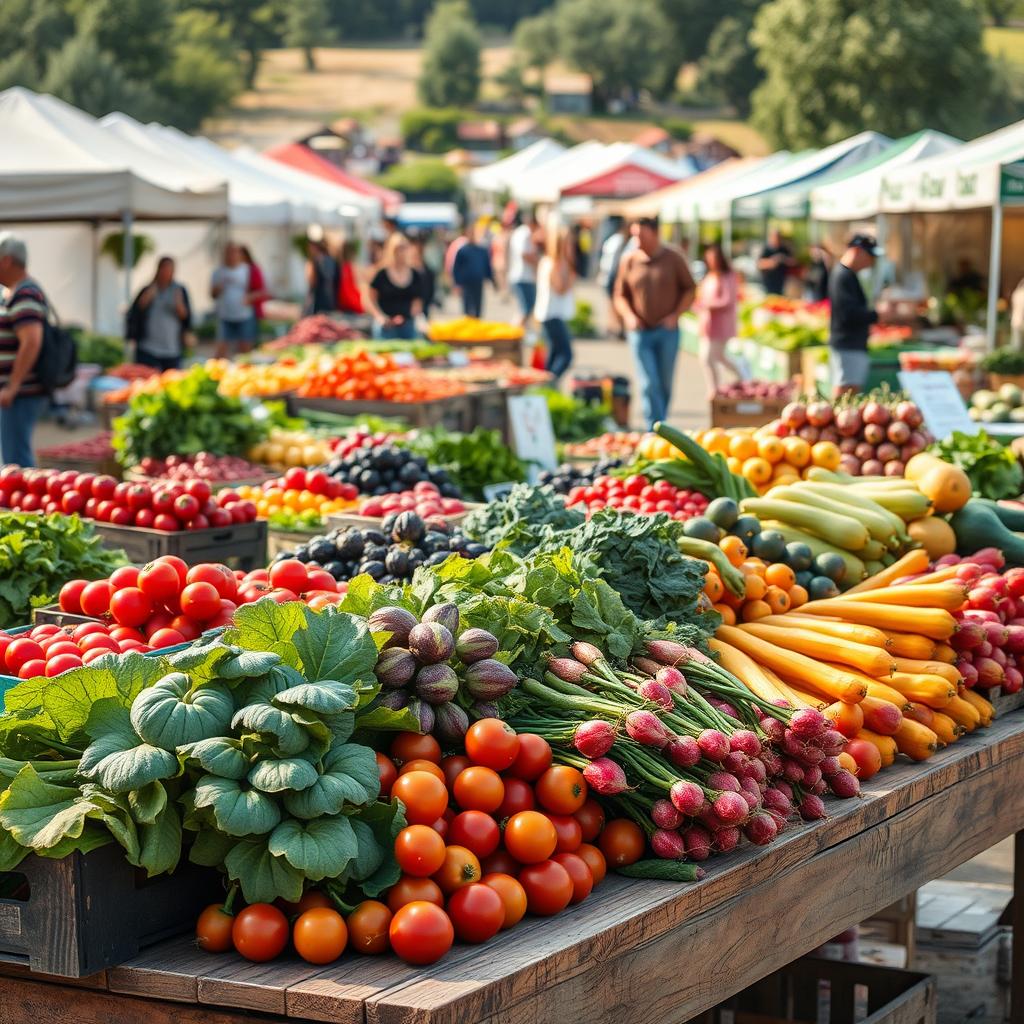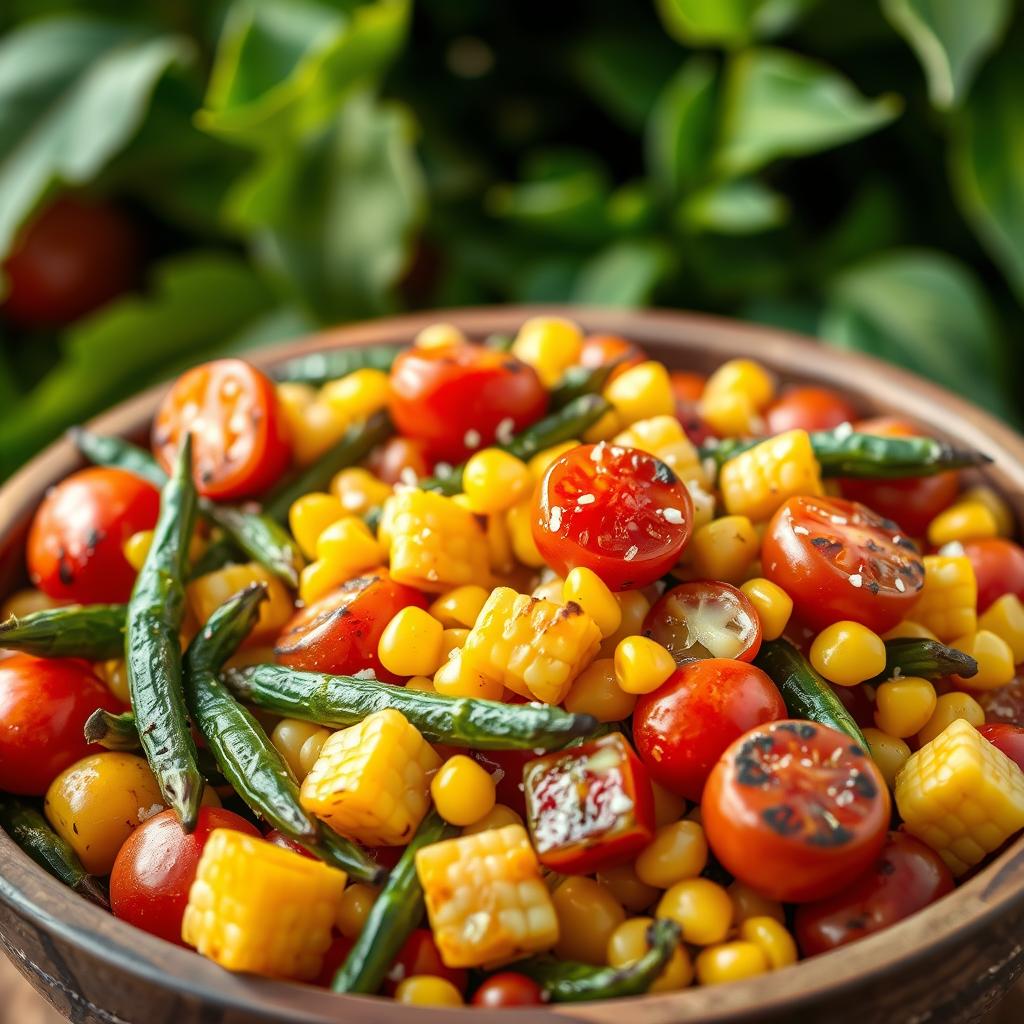Summer brings back memories of grilling fresh veggies. The colors of local ingredients pop, promising a tasty adventure. Farm-to-table cooking is more than food; it’s a way to celebrate the season’s best.
Picture making a salad that feels like a sunny farm day. Our grilled okra, corn, and tomato salad is a true farm-to-table dish. It combines fresh, local ingredients that are sweet and smoky.
This recipe is a trip to local farms, showing off amazing community produce. By cooking farm-to-table, you support local farmers and connect with your food.
Key Takeaways
- Farm-to-table cooking celebrates fresh, locally sourced ingredients
- Grilling vegetables enhances their natural flavors
- Seasonal ingredients create the most delicious and nutritious meals
- Supporting local farmers creates community connections
- Simple recipes can transform fresh produce into extraordinary dishes
Understanding Farm-to-Table Philosophy

Farm-to-table is more than a food trend. It’s a way to connect people with where their food comes from. It celebrates sustainable farming and the slow food movement’s values of mindful eating and buying local.
The movement started as a reaction to big food systems that hide where food comes from. Chefs and farmers teamed up to show the hard work behind fresh, local food.
Roots of the Farm-to-Table Movement
The farm-to-table cooking movement began with several important steps:
- People started caring more about food quality and nutrition.
- There was a growing interest in sustainable farming.
- Supporting local farmers became a priority.
- Concerns about industrial food production grew.
Core Principles of Farm-to-Table Cooking
Farm-to-table cooking is all about:
- Local sourcing of ingredients.
- Backing regional farmers and producers.
- Reducing food transport distances.
- Keeping traditional cooking methods alive.
Online cooking classes and demos teach people about fresh, local food. They show the deep link between food, community, and sustainable farming.
Benefits of Farm-to-Table Cooking
Farm-to-table cooking is more than a trend. It’s a way to eat that connects you with local food and supports the environment. By choosing this method, you join a movement for sustainable agriculture and ethical eating.

Embracing farm-to-table cooking brings many benefits for you and your community. Let’s look at the main advantages:
Environmental Impact
Using local ingredients cuts down your carbon footprint. It reduces emissions from long-distance food transport. This helps the planet by lowering greenhouse gases.
- Reduced carbon emissions from transportation
- Support for sustainable agricultural practices
- Lower energy consumption in food production
Support for Local Communities
Farm-to-table cooking helps local farmers and producers. Your food choices can boost the economy in rural areas.
| Community Benefit | Direct Impact |
|---|---|
| Economic Growth | Increased income for local farmers |
| Job Creation | More employment in local agricultural sectors |
| Food Security | Strengthened local food distribution networks |
By choosing ethical eating and supporting local producers, you do more than cook a meal. You invest in food systems that benefit everyone.
Sourcing Local Ingredients
Exploring locally sourced ingredients can make your cooking amazing. It starts with finding local producers and seasonal produce. These add fresh flavors to your dishes.

The farm-to-table movement is about finding the freshest ingredients. Your local area has many places to get high-quality, seasonal produce. This can make every meal better.
Finding Farmers’ Markets and CSAs
CSA programs and farmers’ markets are full of great ingredients. They connect you with local farmers who grow food with love and care.
- Research local farmers’ markets in your area
- Sign up for CSA programs that deliver weekly produce boxes
- Download apps that help locate nearby farmers’ markets
- Check community bulletin boards for local farm information
Building Relationships with Local Producers
Connecting with local farmers is more than just buying food. It lets you know the story of your ingredients. It also supports farming that’s good for the planet.
Here are tips for visiting farmers’ markets or local farms:
- Ask farmers about their growing practices
- Learn about seasonal availability of produce
- Share your culinary interests and recipe ideas
- Attend farm-to-table events and workshops
Choosing locally sourced ingredients improves your cooking. It also helps your local farmers.
Essential Tools and Techniques for Farm-to-Table Cooking
Making tasty farm-fresh meals is more than just using good ingredients. You also need the right tools and cooking skills. These help turn local produce into amazing dishes that keep their natural flavors and nutrients.

Starting with farm-fresh meals means choosing the right kitchen gear. Good tools make your cooking better by bringing out the best in local ingredients.
Essential Kitchen Equipment for Fresh Ingredient Preparation
- Sharp chef’s knife (like the Avanta 8″ BBQ Knife crafted from German steel)
- Reliable sheet pans for roasting vegetables and proteins
- Cast-iron skillet for sautéing and frying
- Mandoline slicer for consistent vegetable cuts
- High-performance blender for soups and purees
Cooking Techniques to Preserve Flavor and Nutrients
Learning how to cook is key to keeping your ingredients fresh. Each method brings out the best in your farm-fresh ingredients, keeping their flavors and nutrients intact.
| Technique | Best For | Key Seasonings |
|---|---|---|
| Roasting | Vegetables, proteins | Olive oil, garlic powder, dried herbs |
| Sautéing | Quick-cooking ingredients | Garlic, ginger, chiles |
| Steaming | Delicate vegetables | Minimal seasoning to preserve natural flavors |
| Reduction | Vinaigrettes, sauces | Citrus juices, herb-infused oils |
Knowing these cooking methods lets you create unforgettable farm-to-table meals. These dishes celebrate local produce and your creativity in the kitchen.
Planning Your Farm-to-Table Menu
Creating a tasty farm-to-table menu needs careful planning. It’s all about understanding seasonal produce. Start by embracing local ingredients and turning them into meals that excite your taste buds.
Crafting a Seasonal Menu
Think about the unique tastes and when each produce is available. Each season brings its own special flavors:
- Spring: Tender greens, asparagus, and early strawberries
- Summer: Vibrant tomatoes, corn, and zucchini
- Fall: Root vegetables, squash, and hearty greens
- Winter: Robust root crops, citrus fruits, and preserved vegetables
Balancing Flavors and Textures
Creating memorable meals is more than picking fresh ingredients. Texture and flavor balance are key to making simple ingredients shine.
Here are some tips for your menu:
- Combine crisp and soft textures
- Mix sweet, sour, and savory elements
- Layer different cooking techniques
- Use herbs and spices to enhance natural flavors
By focusing on these points, you’ll make meals that are not only healthy but also incredibly tasty.
Farm-to-Table Recipes for Every Season
Cooking with seasonal produce makes your meals special. It connects you to local farmers and their fresh ingredients. By using seasonal ingredients, you’ll improve your cooking and help local farmers.
Spring and Summer Vibrant Dishes
Spring and summer bring lots of colorful, fresh foods. These are great for light, refreshing salads. Here are some highlights:
- Beet and Asian Pear Salad with miso-honey dressing
- Charred Cabbage Salad featuring chile-lime butter
- Arugula Salad with Asian pears and pumpkin seeds
- Halloumi and Kale Salad with yogurt-based dressing
Fall and Winter Comfort Foods
When it gets colder, your meals can get heartier. These recipes use root vegetables and strong flavors:
- Sweet Potato Salad with smoked paprika and hot honey
- Beet and Herb Salad topped with pistachios
- Miso and Mustard Salad with mushrooms
- Thanksgiving Salad featuring seasonal beets and pears
Each recipe follows the farm-to-table philosophy. It turns simple, local ingredients into amazing dishes. These dishes celebrate the variety of each season.
Preserving the Harvest
In the world of sustainable agriculture, preserving your farm-fresh ingredients is an art form. It connects you to the slow food movement. By learning preservation techniques, you can keep seasonal produce fresh longer. This reduces food waste and lets you enjoy local flavors all year.
Preservation methods let you keep the essence of seasonal ingredients alive. They create delicious, long-lasting food experiences. Each technique has its own benefits for keeping your locally sourced produce fresh and flavorful.
Canning and Pickling Techniques
Canning and pickling are old methods that turn fresh ingredients into tasty treats. Try these exciting techniques:
- Pickling red onions to add tangy flavor and extend shelf life
- Creating jam from unique ingredients like firethorn berries
- Preserving citrus elements such as Cara Cara orange segments
- Using sherry vinegar and balsamic vinegar for added preservation
Freezing and Drying Methods
Freezing and drying are more ways to preserve your harvest. They keep nutritional value high. Some practical approaches include:
- Roasting beets with skins on to preserve color and texture
- Toasting nuts like hazelnuts and pecans to enhance flavor
- Using an ice water soak to prepare delicate ingredients
- Incorporating preserved cheeses like Parmigiano Reggiano
By embracing these preservation techniques, you’ll reduce food waste. You’ll also connect more deeply with sustainable agriculture and the slow food movement. Your kitchen will become a vibrant center of culinary creativity and mindful eating.
Farm-to-Table Dining Out
Exploring ethical eating beyond your home kitchen opens up a world of culinary experiences. Farm-to-table cooking is more than just making meals. It’s a way of life that includes dining out. Knowing how to find and support restaurants that use local, sustainable ingredients can change your dining experiences.
Identifying Authentic Farm-to-Table Restaurants
Looking for real farm-to-table restaurants? Here’s what to look for:
- Seasonal menu changes that show off local harvests
- Visible partnerships with local farmers and producers
- Transparency about where ingredients come from
- Chefs who talk openly about where they get their ingredients
Essential Questions for Ingredient Sourcing
Make your dining experience better by asking restaurants these questions:
- Where do your main ingredients come from?
- How often do you change your menu to match the seasons?
- Do you work directly with local farmers?
- What percent of your ingredients are from around here?
| Restaurant Characteristic | Farm-to-Table Commitment Level |
|---|---|
| Seasonal Menu | High |
| Local Farmer Partnerships | High |
| Ingredient Traceability | Medium to High |
| Chef Engagement | High |
By using these tips, you’ll become a diner who supports ethical eating and real farm-to-table cooking. Your choices help local food systems and sustainable farming.
The Future of Farm-to-Table
The farm-to-table movement is changing fast. It’s using new tech and creative ways to farm sustainably. As people care more about the planet, how we make and eat food is changing too.
Emerging Trends in Sustainable Cooking
Chefs and restaurant owners are finding new ways to make food that’s good for the planet. They’re changing how we get and make food:
- Virtual cooking shows that link us to local farmers
- More focus on using ingredients from right around us
- Technology to track where our food comes from
- Ways to cook that waste less food
Technology Revolutionizing Farm-to-Table Practices
Online platforms are changing farming by linking farmers directly with us. Smart farming technologies help grow food better and waste less. This makes farming more efficient and kinder to the planet.
Some big tech changes include:
- Blockchain to show where food comes from
- Apps to find local farms
- Tools for precise farming
- Systems to watch over crops
Chefs like René Redzepi and Daniel Patterson are showing us new ways to cook. They use wild herbs and focus on local, seasonal food. Their cooking celebrates nature.
As the farm-to-table movement keeps growing, expect more places to use these green practices. This will make our food system more connected and caring for the planet.
Conclusion: Embracing the Farm-to-Table Lifestyle
Your journey into farm-to-table cooking is more than a trend. It’s a strong support for organic farming and enjoying natural flavors from local sources. By picking ingredients grown nearby, you make your kitchen a center of sustainable food.
Your food choices have big effects. Local farmers get more support, and you get fresher, healthier food. Organic farming also protects our planet, cuts down on carbon, and saves farm diversity for the future.
Starting your farm-to-table journey is easy. Start with small steps like visiting farmers’ markets, joining a CSA, or growing herbs. Every choice to use local, seasonal ingredients helps our food system and connects you to where your food comes from.
Your cooking journey can lead to big changes. As you explore the rich flavors of local ingredients, you’ll improve your cooking and join a movement for sustainable food systems.

